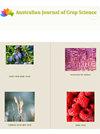Intercrops of grass with legumes as green manure for agroecological systems
Q3 Agricultural and Biological Sciences
引用次数: 0
Abstract
The stud article aimed to assess the accumulation and rates of nutrients in the biomass of the consortium of millet and leguminous plants for green fertilisation. The treatments were consortia of millet with four different leguminous plants: Cajanus cajan, Canavalia ensiformis, Mucuna aterrima, and Dolichos lablab. The treatments were distributed in a completely randomised design with four replications. The species of each consortium were planted in a line, at a distance of one metre apart. The aerial part of the plants was harvested after 90 days to determine the botanical composition, intercropping biomass, and the amount and accumulation of macronutrients in the biomass. The Millet mass did not differ among the consortia. However, among the legumes, M. aterrima has the highest mass (2806.31 kg/ha DM), which is reflected in the lower ratio of leguminous grasses in the millet consortium with M. aterrima (4.61). The consortia affected the rate and accumulation of P, B, and Fe. The biomass of the millet consortium with C. cajan presented the lowest rate. In addition, the accumulation of K, Mg, and Zn was low in this consortium. The biomass of millet intercrops with M. aterrima, D. lablab and C. ensiformis showed higher accumulations of K, Ca, and Mg. The highest accumulation of N was observed in the biomass of the consortium with M. aterrima (50.71 kg/ha). The rates and accumulations of Cu and Zn were higher in the consortium with M. aterrima. The consortium of millet with the leguminous plants is a sustainable alternative for fertilisation. The consortia with M. aterrima and D. lablab are the most promising ones, due to the higher proportion of plants.草地与豆科植物间作农业生态系统绿肥的研究
本研究旨在评估谷子和豆科植物群落生物量中营养物质的积累和速率。以谷子与四种豆科植物(Cajanus cajan、Canavalia ensiformis、Mucuna terrima和Dolichos lablab)为处理组合。治疗采用完全随机设计,有4个重复。每个联合体的物种被种植成一行,相距一米。90 d后采收地上部分,测定植物组成、间作生物量、生物量中常量营养素的数量和积累量。谷子的质量在不同的群体中没有差别。而豆科植物中,豆科草的质量最高,为2806.31 kg/ hm2,这反映在谷子群中豆科草的比例较低(4.61 kg/ hm2)。群落影响了磷、硼和铁的速率和积累。谷子群落生物量最低,谷子群落生物量最低。此外,该群落的钾、镁、锌积累量较低。谷子间作中含有较多的钾、钙、镁。水蛭群落生物量氮积累量最高(50.71 kg/ha)。铜和锌的富集率和积累量在与水蛭共生的菌群中较高。谷子与豆科植物的结合是一种可持续的施肥选择。与M. aterrima和D. lablab组成的联合体因其较高的植物比例而最有希望。
本文章由计算机程序翻译,如有差异,请以英文原文为准。
求助全文
约1分钟内获得全文
求助全文
来源期刊

Australian Journal of Crop Science
农林科学-农艺学
CiteScore
1.20
自引率
0.00%
发文量
75
审稿时长
3.5 months
期刊介绍:
Information not localized
 求助内容:
求助内容: 应助结果提醒方式:
应助结果提醒方式:


